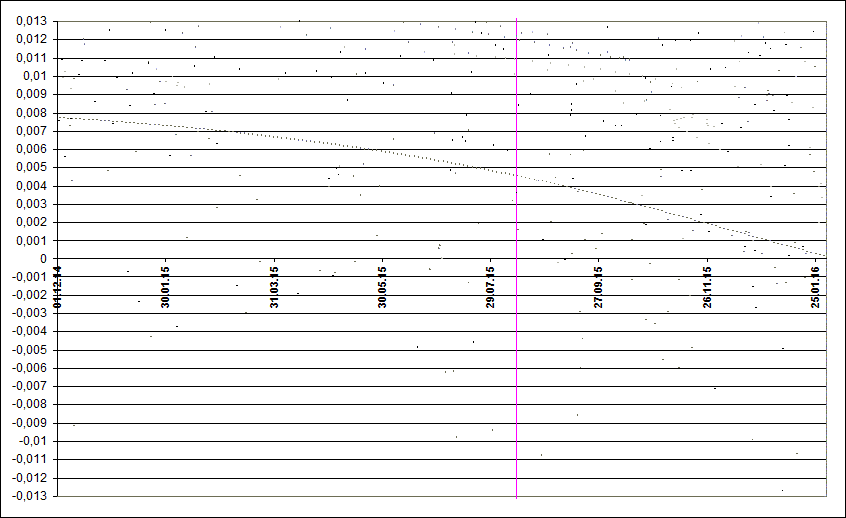Perseids 2016: prediction of activity
to the list of predictions

Fig. 1. Space-temporal projection of Perseid trails parts onto their minimal distance passages in 2015 (correspondence between colours of the particles and their ejection velocities can be seen here).
In 2015-2017 the Earth will encounter the perturbed part of Perseid stream, which was shifted closer to the Earth's orbit by Jupiter gravitation. This means that in these years we have to expect heightened Perseid activity. The mostly shifted particles (by about 0.01 AU) will encounter the Earth just in 2016. Therefore we expect significant increase of Perseids background activity with ZHR of 150-160. Time of background maximum, corresponding to solar longitute 140.0° (IMO data) is 12:40 UT on August 12.
Besides heightened background maximum there could be other Perseid peaks in 2016. For example, on 11 August 22:34 UT the Earth will pass at 0.00134 AU from 1862 trail (1 revolution). Its particles ejection velocity is quite high - 42.76 m/s, so we expect that activity increase from this trail would be not very high, with it own ZHR of 10-20 above background activity. Brightness of 1862 trail meteor should be low. In the same time, in radiorange the outburst magnitude could be much stronger.
Less than an hour later, on 11 August 23:23 UT another encounter is expected - with 1479 Perseid trail (4 rev). Ejection velocity is 5.30 m/s, which assumes bright meteors. Perhaps the outbursts from 1861 and 1479 trails will partially merge giving overall activity inrease of several dozens meteors above background during the period from 11 Augist 22 UT to 12 August 0 UT. This is approximately 0.5 days before background maximums, so we could expect that overall ZHR level (with background) dirung this outburst would be 120-130 meteors.
References
1. "Comet's dust 2.0" program by S. Shanov and S. Dubrovsky. [Used for orbital computations.]
2. Lyytinen E, van Flandern T. "Predicting the strength of Leonid outbursts", 2000, Icarus, P. 158-160.
3. Kasuo Kinoshita, http://jcometobs.web.fc2.com/ [Orbital elements of the comet 109P Swift-Tuttle]
4. Jenniskens P. Meteor showers and their parent comets, 2006, 780 p.
Besides heightened background maximum there could be other Perseid peaks in 2016. For example, on 11 August 22:34 UT the Earth will pass at 0.00134 AU from 1862 trail (1 revolution). Its particles ejection velocity is quite high - 42.76 m/s, so we expect that activity increase from this trail would be not very high, with it own ZHR of 10-20 above background activity. Brightness of 1862 trail meteor should be low. In the same time, in radiorange the outburst magnitude could be much stronger.
Less than an hour later, on 11 August 23:23 UT another encounter is expected - with 1479 Perseid trail (4 rev). Ejection velocity is 5.30 m/s, which assumes bright meteors. Perhaps the outbursts from 1861 and 1479 trails will partially merge giving overall activity inrease of several dozens meteors above background during the period from 11 Augist 22 UT to 12 August 0 UT. This is approximately 0.5 days before background maximums, so we could expect that overall ZHR level (with background) dirung this outburst would be 120-130 meteors.
References
1. "Comet's dust 2.0" program by S. Shanov and S. Dubrovsky. [Used for orbital computations.]
2. Lyytinen E, van Flandern T. "Predicting the strength of Leonid outbursts", 2000, Icarus, P. 158-160.
3. Kasuo Kinoshita, http://jcometobs.web.fc2.com/ [Orbital elements of the comet 109P Swift-Tuttle]
4. Jenniskens P. Meteor showers and their parent comets, 2006, 780 p.